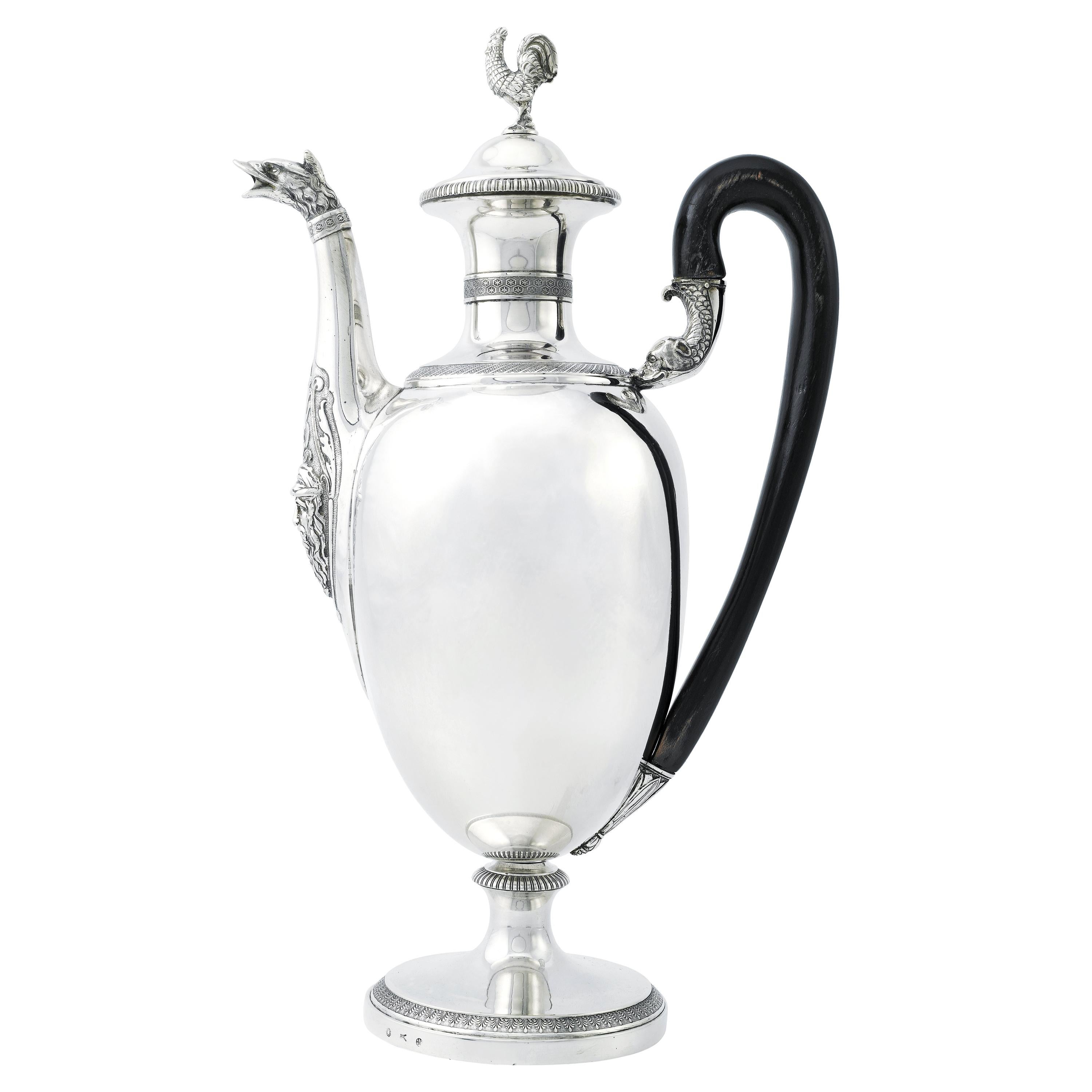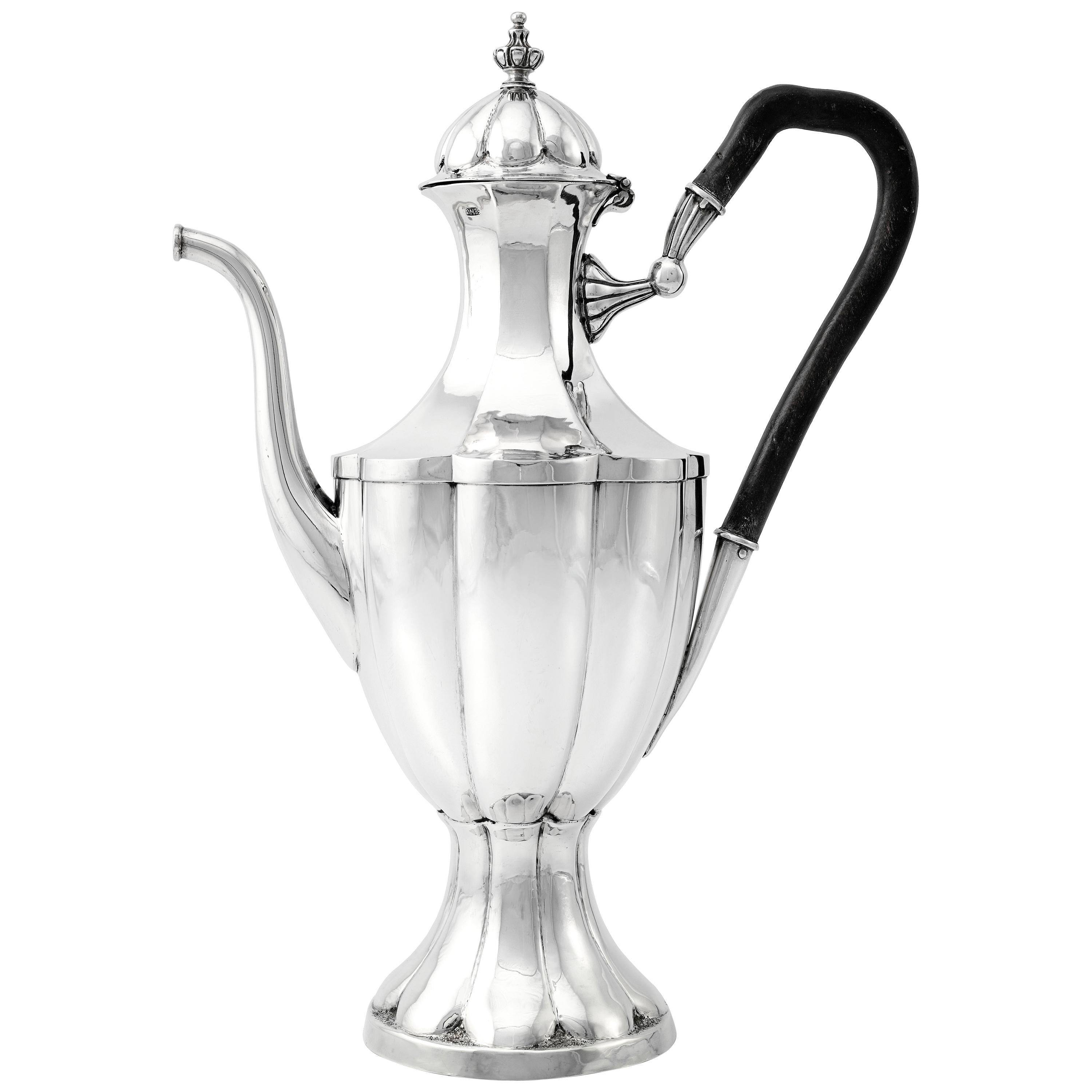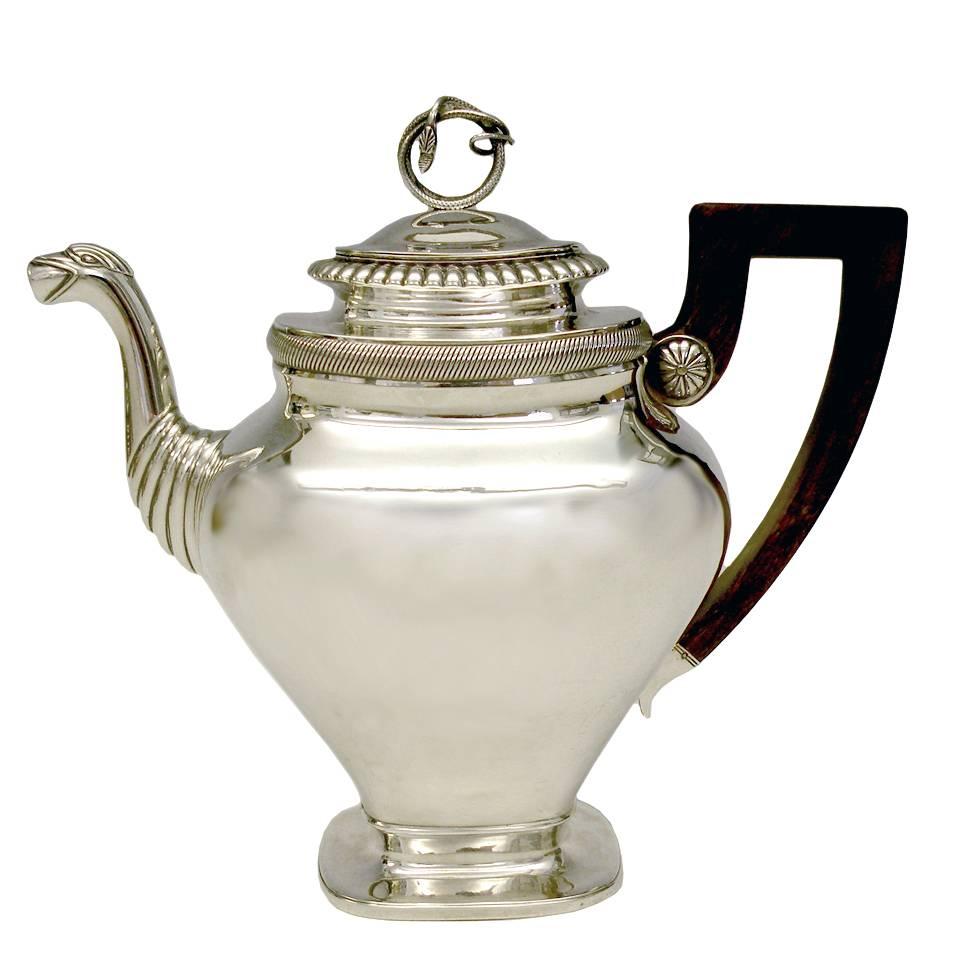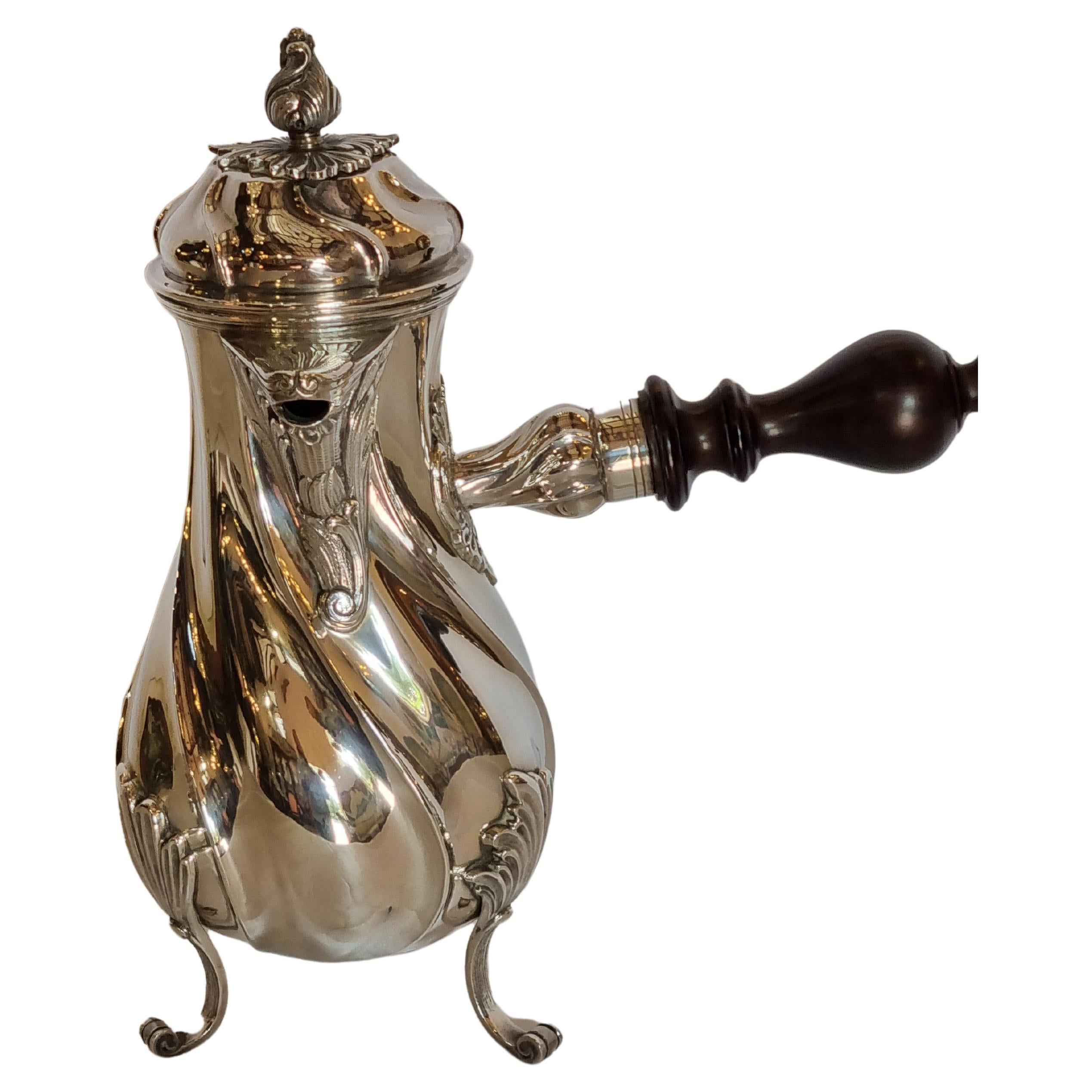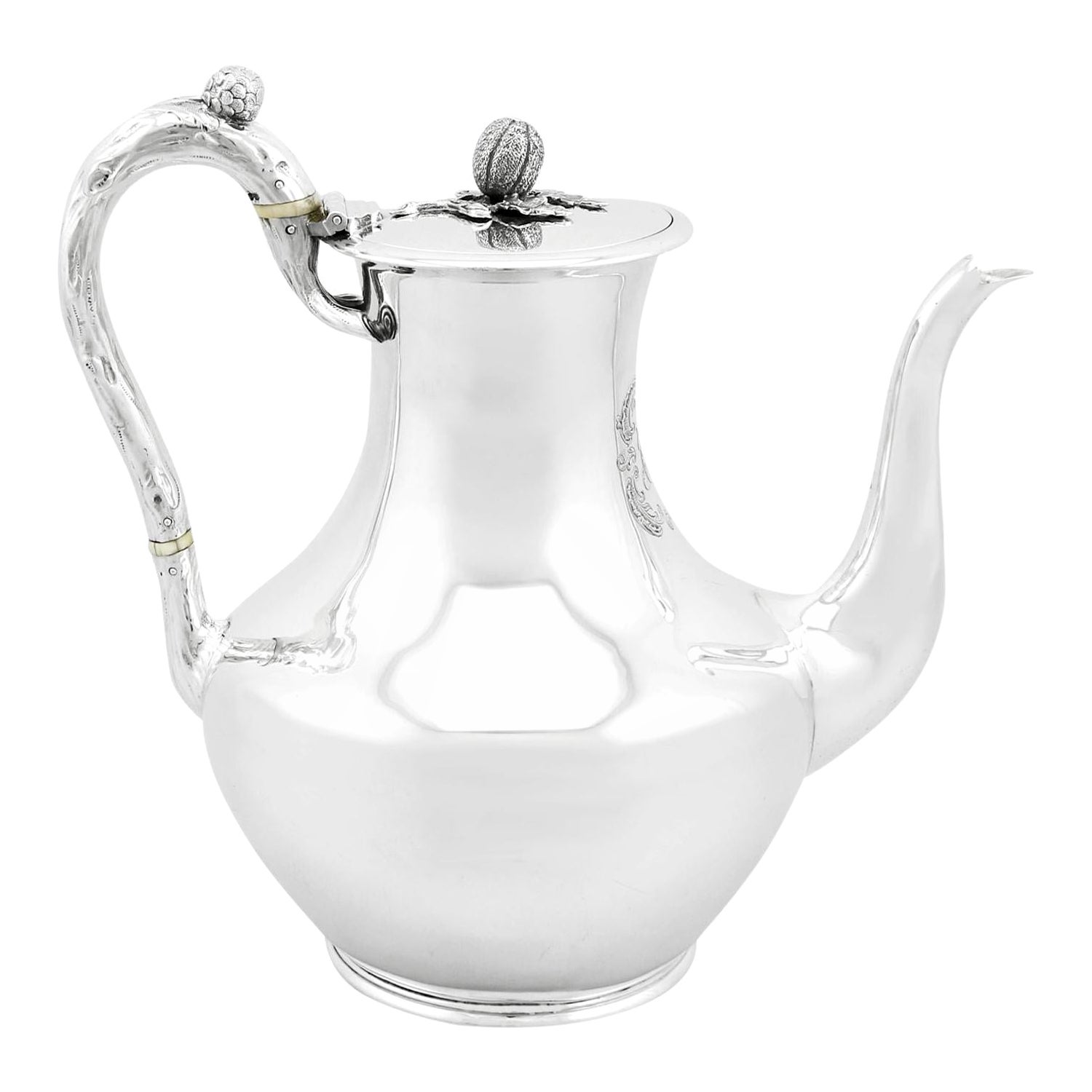Items Similar to Ancient Italian Neoclassic Sterling Silver Coffee Pot, Milan, circa 1850
Video Loading
Want more images or videos?
Request additional images or videos from the seller
1 of 21
Ancient Italian Neoclassic Sterling Silver Coffee Pot, Milan, circa 1850
About the Item
Embossed and engraved sterling silver coffee pot
Tommaso Panizza (1805-1868)
Milan, circa half of the 19th century
It measures 13.97 in (cm 35.5) in height x 8.66 in (22 cm) x 4.72 in (12 cm)
It weighs 1.94 lbs (884 g)
State of conservation: Good
The silver coffee pot has a round mouthpiece with a marked everted rim on which rests a convex lid surmounted by a knob in the shape of a winged griffin with a border decorated with two different types of pods. The cylindrical neck, adorned with a corded band, goes down to a rounded shoulder which forms a small detachment and is embellished with the same motif as the edge of the lid. The ovoid, smooth body narrows sharply downwards to join a cup-shaped foot with an everted detachment ring. The foot itself is decorated with a corolla-shaped pod and opens into a base adorned with the same motif as the edge of the lid and the shoulder. From the shoulder, on the front, there is a long spout which ends in a griffin's head and has at its base the head in relief of a young man with flowing hair, topped with a Persian palmette. On the back a tall and strongly curved handle of ebonized wood extends from a decorative dog's head rhyton and ends in a bearded mask in relief.
The marks can be seen on the edge of the foot (the original descriptions are reported, as they appear on the documents of the State Archive of Milan):
1) “Forma eptagona. Globo col Zodiaco ed i setti (sic) Trioni.”
Heptagon form. Globe with the Zodiac and the seven Trioni (seven stars of the Ursa Major).
Mark of the Guarantee Office in use in the Napoleonic Kingdom of Italy from 1812 for works with a title of 800 thousandths.
2) “Aratro”.
Plow.
Mark of the Guarantee Office in use in the Napoleonic Kingdom of Italy from 1812.
3) Capra che allatta e lettere TP.
Nursing goat and letters TP.
Mark of the silversmith Tommaso Panizza.
Reference bibliography for marks:
G. SAMBONET, Gli argenti milanesi, Milano 1987, pp. 37-40; e pp. 98 – 99.
V. DONAVER - R. DABBENE, Punzoni degli argentieri milanesi dell’800, Milano 1988, pp. 18-21 e p. 87-88, n. 91.
- Creator:Tommaso Panizza (Maker)
- Dimensions:Height: 13.98 in (35.5 cm)Width: 8.67 in (22 cm)Depth: 4.73 in (12 cm)
- Style:Neoclassical (Of the Period)
- Materials and Techniques:Sterling Silver,Embossed
- Place of Origin:
- Period:
- Date of Manufacture:circa 1850
- Condition:Minor fading.
- Seller Location:Milano, IT
- Reference Number:1stDibs: LU4352216028472
About the Seller
4.3
Vetted Seller
These experienced sellers undergo a comprehensive evaluation by our team of in-house experts.
Established in 1860
1stDibs seller since 2018
19 sales on 1stDibs
Typical response time: 4 hours
Associations
International Confederation of Art and Antique Dealers' Associations
- ShippingRetrieving quote...Ships From: Milano, Italy
- Return PolicyA return for this item may be initiated within 14 days of delivery.
More From This SellerView All
- Large Italian Neoclassic Sterling Silver Coffee Pot, Milan, Circa 1830Located in Milano, ITEmbossed and engraved silver coffee pot Antonio Garavaglia Milan, Circa 1830 It measures 16.92 in (43 cm) in height and weighs 3.35 lb (1.520 gr) State of conservation: very good The large silver coffee pot has a round mouthpiece with a marked everted rim on which a pagoda lid rests; this is surmounted by a cock-shaped knob with a border decorated with small pods...Category
Antique 1820s Italian Neoclassical Sterling Silver
MaterialsSterling Silver
- Ancient Neoclassic Sterling Silver Coffee Pot, Palermo, Sicily circa 1789Located in Milano, ITAncient Neoclassic Sterling Silver Coffee Pot, Palermo, Sicily circa 1789 Embossed and engraved silver coffee pot Silversmith, probably Agostino Natoli Diego Di Maggio, Silversmith Consul in 1789 and 1796 Palermo, 1789 It measures 14.17 in (36 cm) high and weighs 2.76 lb (1.252 g) State of conservation: few signs of use and some slight blemishes The large silver coffee pot has a round mouthpiece with a markedly everted rim, on which hinges a domed lid with very full molded pod shapes; a closed bud surmounted by a small sphere serves as a knob. The polygonal neck descends and widens into molded elements that come together, with larger pods, at the point where it is attached to the body. The body in turn is united to a well-shaped foot, which ends in a flat base with a vertical rim. From the body rises a spout with a circular mouth accented with a thick rim. An angled loop, made of ebonized wood, is applied to the neck by means of a double-cone element having a sphere at its center; it ends in a silver cone...Category
Antique 1780s Sicilian Neoclassical Sterling Silver
MaterialsSterling Silver
- Italian Silver Puerperal Cup or Small Soup Tureen, Milan Circa 1830Located in Milano, ITSilversmith L. B. Small silver soup tureen or puerperal cup with plate and lid Milan, around 1830 Height 19.5 cm (7.67 in) - diameter 21.7 cm (8.54 in) lb 2.14 (kg 0.97) State of conservation: slight use defects and a dent on the plate. From about the mid-16th century, the puerperal soup tureen or puerperal cup became one of the most popular wedding gifts in central Italy. As an auspicious symbol, it replaced the birth table...Category
Antique 1830s Italian Neoclassical Sterling Silver
MaterialsSterling Silver
- Ancient Pair Coffee Pots, Pasquale Rubati Manufacture Milan, 1770 circaBy Pasquale RubatiLocated in Milano, ITPair of small coffee pots. Manufacture of Pasquale Rubati Milan, 1770 Circa Maiolica polychrome decorated “a piccolo fuoco” (third fire). a) height 7.87 x 5.51 x 3.93 in (20 x 14 x ...Category
Antique 1760s Italian Neoclassical Ceramics
MaterialsMaiolica
- 19th Century Italian Sterling Silver Madonna, circa 1830Located in Milano, ITEmbossed and engraved silver plaque La Madonna del lago (The Madonna of the Lake) Probably Milan, post 1824 Brass frame It measures 16.14 in x 13.85 in (41 x 35.2 cm) and it weighs 10.357 pounds (4.698 g): silver 1.31 pounds (598 g) + brass 9.03 pounds (4.100 g) State of conservation: some abrasions on the bottom. The frame is old, but not original. The plaque is made up of a sheet of embossed and engraved silver, and held in a solid brass frame. It depicts the “Madonna del lago” – “Madonna of the Lake” - (the Madonna with Child and San Giovannino) by Marco d'Oggiono (Oggiono, 1474 circa - Milan, 1524 circa), while changing only the background landscape. Almost certainly the subject reproduced in the plaque was taken from a famous engraving by Giuseppe Longhi (Monza, 1766 - Milan, 1831), one of the greatest engravers of his era. The silver is unmarked, probably because originally the Madonna was due to be exposed in a church: sometimes precious metals destined for worship and liturgical use would be exempted from payment and were, therefore, not marked. It is very likely that the plaque was made in Milan because in this city in 1824 the engraving by Giuseppe Longhi was made and printed. In addition, in Milan, the alleged lost painting by Leonardo da Vinci in his Milanese period (1482-1500) would be produced; this is the painting from which Marco d'Oggiono took his version. The painting Marco d?Oggiono was one of Leonardo da Vinci's most brilliant students and collaborators (D. Sedini, Marco d’Oggiono, tradizione e rinnovamento in Lombardia tra Quattrocento e Cinquecento, Roma 1989, pp. 151-153, n. 56; p. 225, n. 124, with previous bibliography). His style reflects in every way that of the Tuscan Maestro, so much so that he was the one who executed some copies of da Vinci's paintings. The execution of the “Madonna del Lago” probably draws inspiration from a lost painting by the Maestro, created while he was living in Milan (1482-1500). There are many similarities with other works by Leonardo such as the “Vergine delle rocce” or the “Vergine con il Bambino e San Giovannino, Sant’Anna e l’Agnello”. The painting, from which the drawing and then the famous engraving were taken, is found today at the M&G Museum of Bob Jones University in Greenville, South Carolina, where it came to rest after the sale of the Harrington Collection in London in 1917. The work appears in the inventories of the collection of Napoleon and Joséphine Bonaparte at the castle of Malmaison, before 1809. The Malmaison building was born and developed in the 17th and 18th centuries. In the 18th century it belonged to Jacques-Jean Le Coulteux du Molay, a wealthy banker. Later, during the Directory, Joséphine Bonaparte de Beauharnais bought it on April 21st, 1799, but settled at the castle definitively only after her husband separated from her in 1809. She remained there until 1814, the year of her death. When Joséphine died, the estate passed to her son Eugène de Beauharnais, who moved to Munich with his whole family in 1815, bringing with him the collection of paintings he inherited from his mother. Eugène died in 1824 and his wife Augusta of Bavaria (von Bayern), unable to keep it, in 1828 sold the Malmaison to the Swedish banker Jonas-Philip Hagerman. It is likely that in this period Augusta also sold part of the paintings inherited from her husband, including the “Madonna del Lago”. This painting then came into the possession of Leicester Stanhope, fifth Earl of Harrington (1784 - 1862) and then was passed down to his descendants. In 1917, at the death of Charles, eighth Earl of Harrington, his brother Dudley inherited the title and properties and he put up a part of his collections for sale. Among these, precisely, the painting by Marco d'Oggiono was to be found. On the occasion of that auction the painting was presented as a work by Cesare da Sesto, by virtue of a handwritten note by the Countess of Harrington on the back of the table. However, already in 1857, the German critic Gustav Waagen had identified Marco d'Oggiono as the author of the painting, then exhibited in the dining room of Harrington House in London (Treasures of Art in Great Britain, in 4 volumes, London, 1854 and 1857). The engraving Giuseppe Longhi was one of the most renowned engravers in Italy between the end of the 18th century and the first quarter of the 19th century. In 1824 Giuseppe Longhi, based on a design by Paolo Caronni, made a famous engraving of the painting of Marco d?Oggiono. The activity of Longhi was then at the peak of his notoriety, enough to earn him very substantial commissions; it is not risky to suppose that some of his successful engravings were also reproduced using other means: in our case in silver. (A. Crespi, a cura di, Giuseppe Longhi 1766–1831 e Raffaello Morghen...Category
Antique 1820s Italian Neoclassical Sterling Silver
MaterialsSterling Silver, Brass
- Ancient Italian Renaissance Maiolica Crespina, Faenza, 1580 CircaLocated in Milano, ITCrespina Faenza, last quarter of the 16th century Maiolica painted in two colors, light blue and yellow, on a thick, rich layer of white enamel. It measures 2.24 in (5.7 cm) in height, 6.10 in (15.5 cm) in diameter. lb 0.55 (kg 0.25) State of conservation: mimetic restoration. The small cup has a raised central “umbone”, a perforated brim and a shaped rim. It rests on a high jutting foot. The "crespina" shape, in some inventories is cited as "tacce de frute" (fruit cups). It was particularly appreciated in the Renaissance and has variants based on the formal types and the different sizes. The decoration, made according to the dictates of the “compendiario” style, used few standardized colors: blue and yellow on a thick white and shiny enamel, deliberately chosen as the colour which was most reminiscent of silver. This choice derived from a trend in creative design of the era: the shapes used in the molds were often taken from metal objects. An idea which would last throughout the Renaissance. The work shows, in the middle of the “umbone”, a winged putto stepping forward while playing a long thin trumpet. The depiction of the putto is fully representative of the repertoire of the Faenza workshops of the sixteenth century. Some specimens with this type of decoration have been published in a volume by Carmen Ravanelli Guidotti: there appears the whole productive repertoire of this fundamental moment of transition between the taste for the “istoriato” style and the great simplification of decoration in the “compendiario” period. This style, in its simplicity, however, saw its expression in a rather varied collection of decorative subjects, including old-fashioned busts...Category
Antique 16th Century Italian Renaissance Ceramics
MaterialsMaiolica
You May Also Like
- Gorgeous Sterling Coffee Pot by Albertus Homan Circa 1830sBy Albert HomanLocated in Litchfield, CTCirca 1830s, .875 fineness silver, by Albertus Homan, Amsterdam, Netherlands. After two hundred years, this coffee pot is as urbane and au courant as the day it was made. The Nederla...Category
Antique 19th Century Dutch Serving Pieces
- 20th Century Rococo Style Sterling Silver Chocolate/Coffee Pot , Italy, 1989By Ilario Pradella 1Located in Cagliari, ITExtraordinary reproduction of an Italian coffee / chocolate pot of the 18th century hand made by Ilario Pradella for Bellezza Cagliari. Splendid chisel work typical of the Milanese ...Category
Vintage 1980s Italian Rococo Sterling Silver
MaterialsSterling Silver
- Italian Neoclassical Silver Coffee PotLocated in New York, NYItalian Neoclassical Silver Coffee Pot. Neapolitan caffettiera in sterling silver with wood handle of neoclassical form and decoration with parrot lid and canine spout; with Italian ...Category
Antique Early 19th Century Italian Neoclassical Sterling Silver
MaterialsSterling Silver
- 1850s Victorian Sterling Silver Coffee PotBy Joseph & Albert SavoryLocated in Jesmond, Newcastle Upon TyneAn exceptional, fine and impressive antique Victorian English sterling silver coffee pot; an addition to our silver teaware collection. This exceptional antique Victorian sterling silver coffee pot...Category
Antique 1850s English Victorian Sterling Silver
MaterialsSterling Silver, Silver
- Antique Victorian 1862 Sterling Silver Mustard PotBy George John Richards & Edward Charles BrownLocated in Jesmond, Newcastle Upon TyneA fine and impressive, large antique Victorian English sterling silver drum style mustard pot; an addition to our silver cruets/condiments collection. This fine antique Victorian sterling silver mustard pot has a drum shaped form. The surface of this large mustard pot is embellished with bright cut engraved scrolling leaf ornamentation accented with a spray of floral motifs and incorporating two quatrefoil designs. The upper and lower rims are encircled with applied moulded borders. This fine mustard pot retains the original hallmarked hinged cover surmounted with an impressive pierced decorated shaped scrolling thumbpiece. The surface of the cover is embellished further bright cut engraved scrolling leaf and floral designs encompassing a vacant shaped cartouche. This antique mustard pot...Category
Antique 1860s English Victorian Serving Pieces
MaterialsSterling Silver
- Mappin & Webb Sterling Silver Footed Mustard Pot with Glass Liner, Circa 1929By Mappin & WebbLocated in Miami Beach, FLThis beautiful ornate example of a mustard pot by famed Birmingham England silversmith Mappin and Webb was manufactured in 1929. The rim has a scolloped ribbon edge. It then bows out...Category
Early 20th Century English Serving Pieces
MaterialsSterling Silver
Recently Viewed
View AllMore Ways To Browse
Silver Stater
Italian Silver Sterling
Ancient Silver
18century Silver
Sterling Silver Pot
Silver Coffee Pot By
Silver Pot With Lid
Antique Sterling Ring
Antique Sterling Rings
Antique Sterling Silver Ring
Sterling Silver Antique Rings
Sterling Silver Antique Silver Rings
Antique Sterling Silver Rings
X Wood Base Glass Top
Italian 800 Silver
800 Italy Silver
Coffee Pot Antique
Neoclassical Round Dining
